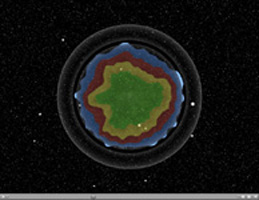
Click on the image for movie of
Order Amidst Chaos of Star's ExplosionThis artist's animation shows the explosion of a massive star, the remains of which are named Cassiopeia A. NASA's Spitzer Space Telescope found evidence that the star exploded with some degree of order, preserving chunks of its onion-like layers as it blasted apart.
Cassiopeia A is what is known as a supernova remnant. The original star, about 15 to 20 times more massive than our sun, died in a cataclysmic "supernova" explosion viewable from Earth about 340 years ago. The remnant is located 10,000 light-years away in the constellation Cassiopeia.
The movie begins by showing the star before it died, when its layers of elements (shown in different colors) were stacked neatly, with the heaviest at the core and the lightest at the top. The star is then shown blasting to smithereens. Spitzer found evidence that the star's original layers were preserved, flinging outward in all directions, but not at the same speeds. In other words, some chunks of the star sped outward faster than others, as illustrated by the animation.
The movie ends with an actual picture of Cassiopeia A taken by Spitzer. The colored layers containing different elements are seen next to each other because they traveled at different speeds.
The infrared observatory was able to see the tossed-out layers because they light up upon ramming into a "reverse" shock wave created in the aftermath of the explosion. When a massive star explodes, it creates two types of shock waves. The forward shock wave darts out quickest, and, in the case of Cassiopeia A, is now traveling at supersonic speeds up to 7,500 kilometers per second (4,600 miles/second). The reverse shock wave is produced when the forward shock wave slams into a shell of surrounding material expelled before the star died. It tags along behind the forward shock wave at slightly slower speeds.
Chunks of the star that were thrown out fastest hit the shock wave sooner and have had more time to heat up to scorching temperatures previously detected by X-ray and visible-light telescopes. Chunks of the star that lagged behind hit the shock wave later, so they are cooler and radiate infrared light that was not seen until Spitzer came along. These lagging chunks are seen in false colors in the Spitzer picture of Cassiopeia A. They are made up of gas and dust containing neon, oxygen and aluminum -- elements from the middle layers of the original star.

